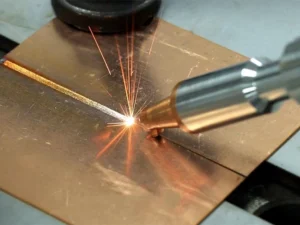Introduction:
Laser technology has high efficiency, high precision, and wide application. It has gradually replaced traditional processing technology and has become an ideal choice for the manufacturing industry. Among them, laser welding is currently the fastest-growing process. This trend is likely to further accelerate the iteration, especially with the popularity of handheld laser welding machines. So how to use a laser welder? This article will give you in-depth answers.
How To Use A Laser Welder- Follow These Steps
The following steps are a general guideline for using a laser welder. The specific operating methods may vary depending on the model of the laser welder and the characteristics of the workpieces involved.

-
Preparation
Ensure that the work area is clean and tidy and all safety measures are in place, such as wearing protective eyewear and gloves. Also, make sure the laser equipment is functioning properly.
-
Set up the equipment
Connect the laser welder to the power source and turn on the power switch. Refer to the user manual of the welder and adjust the equipment parameters according to the specifications, such as power, wavelength, focal length, etc.
-
Prepare the workpieces
Place the workpiece to be welded on the workbench and ensure its position and angle are correct. Clean the surface of the workpiece to remove any oil, dust, or impurities.
-
Align the welding points
Use the laser welder’s alignment device or laser pointer to align the laser beam with the welding points. Make sure the position and direction of the weld points are correct.
-
Start the welding process
Using the laser welder’s control system, initiate the laser beam’s emission and start the welding process. Monitor the temperature, speed, and other parameters during welding and adjust as needed.
-
Inspect the welding quality
After the welding is completed, use inspection tools or visually inspect the quality of the weld. Ensure that the weld’s strength, density, and appearance meet the requirements. If necessary, perform post-weld treatments and refinements.
-
Shut down the equipment
Once the welding work is finished, turn off the power switch of the laser welder and follow the equipment’s operating procedures for cleaning and maintenance.
Safety Precautions When Using A Laser Welder
Before using a laser welder, please thoroughly read and comply with the user manual. Prioritize safety precautions during the operation.

1. Check the working status of the welding machine parts.
Before welding, check whether all parts of the laser welding machine are working normally. After the operation, check the welding machine and the work site to eliminate hidden dangers and ensure safety and no accidents.
2. Avoid laser irradiation.
Direct irradiation or strong laser beam reflection will cause the burning of combustible materials and lead to fire. In addition, there are thousands to tens of thousands of volts of high voltage in the laser, which may cause electric shock injuries. Therefore, only trained personnel are allowed to operate the laser welding machine. The optical path system of the laser must be fully enclosed with metal to prevent direct irradiation. The laser welding workbench should also be shielded to avoid radiation irradiation.
3. Protect your eyes.
The power density of the laser used in laser welding machine welding is very high, and the beam is very thin, which can easily cause damage to human eyes and skin. Therefore, you should protect your eyes during laser welding operations. On-site operators must wear laser-specific protective glasses.
4. Protect your body.
Direct laser irradiation of the skin will cause burns to the skin, and the long-term effects of diffuse reflection will also lead to skin aging, inflammation, and skin cancer lesions of the operator. On-site operators need to wear work clothes to reduce the impact of diffuse reflection.
Compared With Traditional Welding Processes, Laser Welding Has Advantages:
- Good process control: Machine tool control and sensor systems detect process parameters and ensure quality.
- High precision: Laser welding has high welding precision and control capabilities, can achieve fine welds, and is suitable for applications that require high welding quality.
- Non-contact welding: Laser welding is a non-contact welding process that does not cause mechanical stress or deformation to the welding material and is suitable for application scenarios with high requirements for material damage.
- Small heat impact: The heat input of laser welding is small, the local heating speed is fast, and the heat affected area is small, which reduces material deformation and the generation of gas pores.
Multifunctional Applications of Laser Welders
The customer needs handheld laser welding machines suitable for various industries and applications.
It can weld copper and aluminum, including highly reflective materials. It can weld dissimilar materials with different thermal properties, such as steel, aluminum, copper, and stainless steel. It also can switch freely between two common welding processes: wire filler welding and autogenous welding. As a laser tool, handling a variety of common materials and welding processes is one of the basic requirements.
In modern manufacturing, welding is a key process for joining metals and creating stable and durable structures. Traditional welding technologies such as arc welding and argon arc welding have become standard processing methods in light and heavy industries such as aerospace, ships, rail transit, office furniture, advertising and decoration, etc. With the advancement of science and technology, laser welding has become a new standard for welding in industrial applications such as new energy batteries due to its advantages of high welding quality, small heat-affected zone, and high flexibility.
